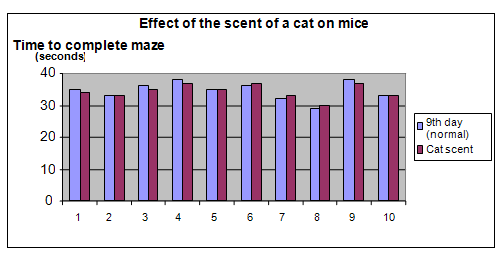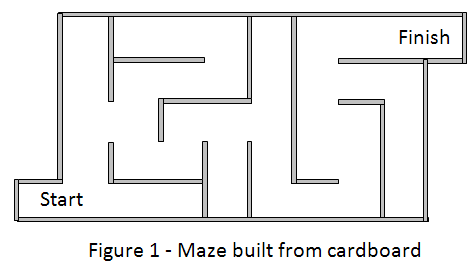| Complexity level: | 6 |
| Project cost ($): | 30 |
| Time required: | 2 days to prepare, 10 days for the science project experiment |
| Material availability: | Mice may be purchased from a pet store |
| Safety concerns: | Handle the mice with care |
Hypothesis
The scent of a cat will cause a mouse to be slower in finding its food.
Overview
Mouse
Mice are mammals that belong to the rodent family. They have long tails and thin fur and are sometimes kept as pets. Mice are quite adaptable to any kind of environment and because they also breed very quickly, they are one of the most prevalent species of mammals on our planet.
Mice are also known to invade homes to scavenge for food and to find shelter. They also spread diseases through parasites that they carry on their bodies, or through their urine and feces. Initially mice were found mostly in farms where they caused many problems by damaging and eating crops. Urbanization brought mice into towns and cities, where they have adapted to living in sewers and drains. Although mice are herbivores, consuming fruit and grains, they have adapted to life in urban cities, eating any kind of scrap food.
Mice are normally preyed upon by larger animals such as cats, larger birds, snakes and wild dogs. They are nocturnal animals that sleep in the day and search for food at night. Therefore, mice have poor eyesight but fortunately for them, an extremely keen hearing and smell. A mouse depends on these senses to locate food and to avoid its predators.
Scientific Terms
Materials
The materials required for this science fair project:
- 10 white mice, purchased from a pet store
- 1 packet of sunflower seed
- Cardboards or old carton boxes (quantity as may be required to make the maze)
- 1 pair of scissors
- 1 roll of masking tape
- 1 bottle of glue
- 1 stopwatch
- 1 meter-length ruler
- 1 cloth, soaked in cat urine (place the cloth in a cat litter box)
Procedure
1. For this science fair project, the independent variable was the whether the maze had the scent of a cat or not. The dependent variable was the time taken for the mouse to complete the maze. This is determined by measuring the amount of time taken using a stopwatch. The constants (control variables) were the size and type of the maze, how hungry the mice were, the type of food used, and the age/breed/parentage of the mice.
2. A maze approximately 500mm x 800mm in size was made using cardboard, glue and masking tape. The walls of the maze were at least 200mm high, to prevent the rodents from jumping out. See figure 1.

3. Once the maze was completed, we left it outdoors for 2 days in order for the smell of the glue dissipate. This was to avoid the mice from being distracted by the smell of glue.
4. A sunflower seed was placed at the end of the maze. The mice were dropped at the start of the maze one at a time. The time taken for each mouse to find the food was recorded.
5. Procedure 4 was repeated once a day for 9 days and it was observed that the mice were fairly consistent in terms of how quickly they were able to solve the maze. The speed of the mice on the 9th day was recorded.
6. On the 10th day, the piece of cloth soiled with cat urine was placed near the end zone of the maze. The 10 mice were placed in maze one at a time, and the amount of time taken by each mouse to complete the maze was measured and recorded.


Results
It was observed that the smell of the cat’s urine did not have any effect on how quickly the mice were able to complete the maze.
|
Time taken by the mouse to complete the maze (seconds) |
||||||||||
|
1 |
2 |
3 |
4 |
5 |
6 |
7 |
8 |
9 |
10 |
|
|
9th day (no cat scent) |
35 |
33 |
36 |
38 |
35 |
36 |
32 |
29 |
38 |
33 |
|
Cat urine scent |
34 |
33 |
35 |
37 |
35 |
37 |
33 |
30 |
37 |
33 |
The chart below shows the results of our science experiment.

Conclusion
Our hypothesis that the scent of a cat will slow a mouse down in a maze, is proven to be false.
Cats have traditionally been kept on farms to hunt and kill mice. Urbanization has brought these archrivals, the cat and the mouse, to cities, although today, most domesticated cats survive on cat food. Many mice are bred in laboratories and pet nurseries and may have never encountered the cat and may possibly have lost the innate instinct of fear towards cats.
Also consider
It might be interesting to observe whether the sound of cat (instead of its scent) will produce different results.
Perhaps our results may also differ if wild mice were caught and used for this experiment.
References
Fear no smell - http://www.nature.com/news/2007/071107/full/news.2007.224.html
Mouse - http://en.wikipedia.org/wiki/Mouse

